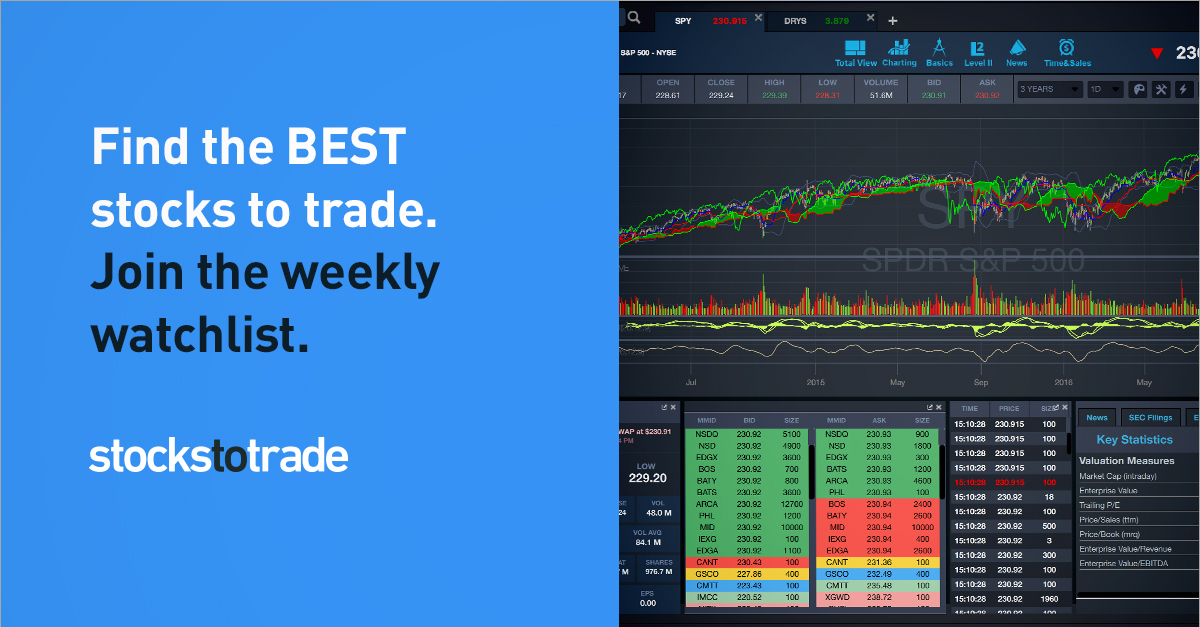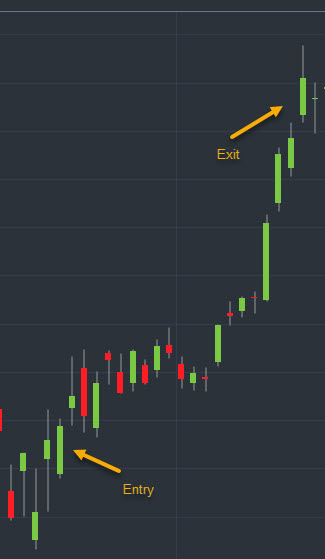If day trading moves too fast or you’re looking for longer-term trading strategies, position trading may be right for you.
Do you want to trade without having to sit in front of the screens all day? Are you a trader who’s busy with other life responsibilities like work, school, or family?
Position trading can give you a way to dip a toe into the market without the high stress of intraday trading. No trading is risk free or easy … but some strategies aren’t as high demand.
It’s all about finding those slow grinders.
In this post, you’ll learn about position trading, what it is, who it’s for, and how to do it…
You’ll also get some cutting-edge tips from the SteadyTrade Team community for finding position trades…
This is a big one, so let’s dive right in!
Table of Contents
What Is Position Trading?
Position trading is a strategy where traders take advantage of multi-week and multi-month moves in a stock price.
Traders can take long or short positions in a stock, and hold them anywhere from around two weeks to about a year.
How Does Position Trading Work?
To help you understand the finer points of this trading style, let’s take a closer look at a hypothetical position trade.
Imagine it’s March 2020, and you believe that Amazon (NASDAQ: AMZN) is set to benefit from a boom in e-commerce spending.
If you’re right, then the price of AMZN could rise over the next few months. So you decide to purchase some shares.
On March 18, you purchase 10 shares at $1,800 each. And you want to make sure to exit the stock if you start losing money. So you place a stop-loss order at $1,600, below the recent price swing low.
Feeling happy with your position, you check on the stock price every couple of days and watch as it zigzags its way up to around $2,400 by late April.
You’re happy with this gain and sell all of your Amazon stock, making a profit of $800 per share.
It doesn’t always work out this clean, and you won’t always make a profit. But position trading can be as simple as this.
Is Position Trading Right for You?
One key to trading consistently is finding a strategy that matches your personality and lifestyle.
If you can’t spend a lot of time in front of your trading screens, due to a job, your family, or any other reason, position trading could be a good fit for you.
Position trading allows more time between trade decisions compared to day trading and swing trading. So, if you don’t handle high-pressure, make-or-break trading situations well, position trading is something you should look at.
To help you get an idea of whether position trading is right for you, here’s a quick break down of how this strategy compares to other major trading strategies.
Position Trading vs. Investing
To a beginner, investing looks very similar to position trading. Both involve holding a stock for a long time, hoping to profit.
Where investing differs, though, is that investors want to sit on a stock for many years, often earning a dividend and a capital gain as the stock price rises. Many investors won’t worry too much about the stock price fluctuating week to week.
On the other hand, a position trader is more focused on stock price action, using a stop-loss as protection if the stock moves against them.
Position traders also rely on charts much more than the typical investor, who often relies heavily on company fundamentals.
Trying to decide between position trading and investing? Know that with position trading, you can potentially manage your risk better, but it will take extra time each week to check your stop-loss levels.
Position Trading vs. Swing Trading
Swing trading involves buying and selling stocks, holding positions for days to weeks.
Most swing trading strategies and techniques are similar to position trading, with traders using the same indicators and chart patterns for entries and exits.
The great thing about swing trading is that it allows you to find more potential trading setups throughout the year. Your capital won’t be tied up in other stocks for long periods as with position trading.
There’s a downside with swing trading … You need to check on your stocks more, often daily or intraday.
Position Trading vs. Day Trading
Day trading is a strategy where you enter and exit trades within the same trading day.
Here, you buy a stock in the morning after a huge catalyst, then sell your position in the afternoon when it’s up maybe 10% or 20% (potentially more in a hot market).
Day trading is high stress. You gotta be there for the action. It’s not right for every trader. The volatility can make for an emotional roller-coaster. You need the right mindset for this strategy. And ready to watch the trade while you’re in it.
Why Position Trading Can Be Great
Still wondering which trading style is right for you? Don’t stress!
First, you can trade using multiple trading styles. I personally day trade, swing trade, and position trade depending on the market environment and my trading goals.
The great thing about position trading is that when stocks make huge moves over weeks and months, you can ride them — if you’re properly prepared.
You can do it without having to sit in front of your screens all day. Your time commitment can be minimal once you do your research and build your trading plan.
Position Trading Strategies
Let’s look at some strategies and techniques that go into finding, analyzing, and taking position trades.
Fundamental Analysis
Fundamental analysis involves looking deeply into what’s happening in a company. To do that, traders will often look through earnings reports, financial records, CEO comments, SEC filings, and more.
By looking through a company’s fundamentals, traders can get an idea of how well a company is doing, its expected profits, and its future outlook.
Fundamental analysis can also help traders to determine whether a stock price seems fairly priced. Knowing this can help position traders understand what long-term investors are thinking, and where they may buy or sell the stock.
Being a skilled fundamental analyst takes serious knowledge. Start prepping here with this post on fundamental analysis.
Technical Analysis
Technical analysis refers to analyzing stock chart patterns, and price and volume behavior to determine a stock’s likely next move.
If you develop your chart-reading skills, you can quickly look at a chart and know whether the stock is in an uptrend or downtrend. And you can determine a smart place for your entry, stop-loss, and so much more.
Chart-reading can range from looking for ultra-simple patterns to complex indicators. A quick tip here — KISS. Keep it simple, stupid. Most of the best traders I know use simple, robust technical analysis.
Technical analysis has existed for hundreds of years. And in that time, thousands of chart patterns and indicators have been developed. There are many books on the subject. (We cover some of them on the SteadyTrade podcast — check out episode 141.)
Check out our guide to common chart patterns here.
Smart Time Frames for Positional Trading
Many traders discuss trading styles by relating them to chart time frames.
For example, they’ll say that day traders look at five-minute charts … Swing traders look at one-hour charts … Position traders look at daily-charts, and investors look at weekly charts.
I think this logic is a bit simple and closed-minded…
It’s smart to look at multiple chart time frames to find the information you need. Here are a few examples…
Short-Term Position Trading
Imagine you want to be in and out of a trade within a month.
You might start by looking at the overall trend on the weekly chart, marking long-term support and resistance levels.
You then look at the daily chart, to get closer to the action, and determine key levels over the past week or two. Then, you look at the one-hour chart to find an entry pattern.
Using all three time frames, you can find an entry point, trading off long-term support, and hopefully making for a great trade.
Long-Term Position Trading
Let’s examine a longer-term trade of somewhere around six months in duration.
You may start by taking a long-term view of the stock’s monthly chart, examining price trends going back for 10 years or more.
Seeing that the stock is in a long-term uptrend, you switch to the weekly chart. That’s where you see a recent pullback pattern. You mark in some key support and resistance areas.
Next, you look at the daily chart for a chart entry. You see a simple breakout pattern, which offers you a smart place to enter, as well as a place to put your stop loss.
By acting as a detective, and looking at a stock price step by step, you’ve found yourself a position trading setup with potential.
3 Handy Tips for Position Trading
Is it time to fire up your trading platform and start hunting for long-term stock setups?
Almost … But before you dive in, here are a few tips for how I’d approach position trading as a newbie.
Make Fundamental Analysis Easy — Use Tip Ranks
Holding stocks for months at a time will often mean you need to analyze a company’s fundamentals. This can be tedious and boring.
Luckily, StocksToTrade has a great feature that can help — the TipRanks tool.
TipRanks shares the analyst rankings and price targets of many stocks.
The analysts are professionals with serious market experience, It’s definitely smart to consider their knowledge. You still gotta do the research, but this tool can help you narrow your search and save time.
TipRanks is an easy-to-use add-on option for StocksToTrade. Make sure you sign up on the account homepage!
Trade With the Trend
One of the most common things I see newbie traders struggle with is that they trade against the trend.
Maybe it’s a rebellious streak, or wanting to prove the market wrong. Whatever it is, I see it a lot. You gotta learn to trade with the trend. (Check out this episode of the TWIST podcast, where Matthew Monaco, Kyle Williams, and Jack Kellogg discuss how the trend is your friend.)
Trading with the trend means riding the overall momentum of the wave. Trade like a sniper. Let the market make higher highs and higher lows, then enter a position.
Focus on Penny Stocks
The stock market is huge, with many different types of stocks being traded each day.
If you’re a trader with a small account, you should focus on stocks that are the easiest to trade and that can allow you to build your account quickly.
I’m talking about penny stocks — stocks that are priced below $10 or so. Some traders say penny stocks are $5 or less per share.
Penny stocks are usually small companies, but they can make massive price moves when everything lines up.
And most of Wall Street ignores these stocks. They’re too small for hedge funds and investment banks … That means they can be easier to trade, as you’re often trading against amateurs. But you gotta know what you’re doing.
First step, focus on your trading education. When you’re ready to start scanning, search for stocks priced below $10 or $5. The criteria is really up to you. There are plenty of educational resources on this blog and our YouTube channel. And you can even connect with me for free on Instagram daily at 8:30 a.m. or noon Eastern.
And if you’re really serious about your trading journey, come join the SteadyTrade Team mentorship and trading community. We hunt for the best low-priced stock trading opportunities every day…
Use StocksToTrade for Position Trading
Bottom line: you need to pick solid trading setups, whether your strategy is position trading, swing trading, day trading, or all of the above.
If you pick the wrong stocks, the price might barely move. Worse, it can go against you. Every trader’s been there. It’s a terrible feeling.
How do you find the best opportunities? Use the smart analysis tools on the StocksToTrade platform. StocksToTrade can give you just about everything you need to research stocks — all within a few clicks of your mouse.
I’m talking about fundamental research, elegant charts, news scanners, stock screeners, chat rooms, and more. It’s a platform for traders designed by traders. We know all the tools that can help make your analysis and trading easier…
Think of StocksToTrade as your highly-equipped command center, allowing you to do war with the markets each trading day.
See what we’re all about. Grab your 14-day trial of StocksToTrade for just $7!
Conclusion
Position trading can be a great trading style if you can’t watch trades all day or need a potentially less stressful way to trade.
If executed well, this trading style could allow you to profit from multi-week and multi-month moves in a stock price.
Don’t think everyone has to follow the high-paced world of day trading. There are so many strategies out there. It’s up to you to find what works best for your lifestyle, account size, and availability.
Watch me as I search for great long-term, short-term, and day trades in real time — join our elite SteadyTrade Team community!
What’s the longest you’ve ever held a stock for? What was the ticker? Tell me below…




